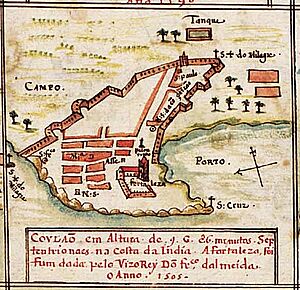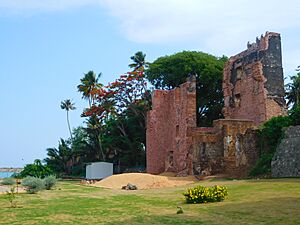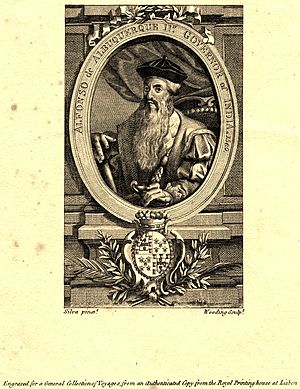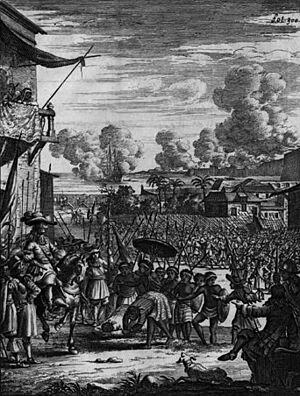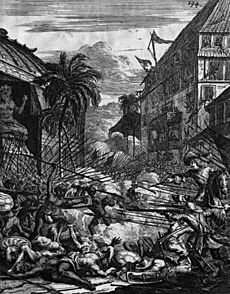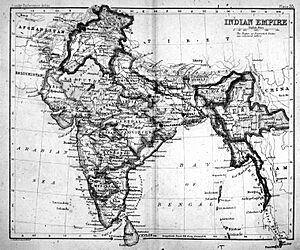History of Kollam facts for kids
Kollam (also called Coulão or Quilon) is a very old city in India. It's one of the oldest port cities on the Malabar Coast. Long ago, it was the capital city of the Venad Kingdom and later the Travancore Kingdom. Kollam was a super important trading port in India. It was also known as Desinganadu. Today, it's famous as the "Cashew Capital of the World."
Since ancient times, Kollam has played a big part in the business, culture, and history of Asia and the Indian subcontinent. The Malayalam calendar (Kollavarsham) is even named after the city! History books say Kollam was connected to Red Sea ports way back in the time of King Solomon. The special teak wood used for King Solomon's throne came from Kollam. Traders from places like Phoenicia, China, the Arab world, and Europe all came to Kollam to trade.
The area around Kollam became an official administrative unit in 1835. Back then, the Travancore state had two main parts, and Kollam was the headquarters for one of them. When Travancore and Cochin joined to form Kerala in 1949, Kollam was one of the first districts created.
Contents
- What's in a Name? The Meaning of Kollam
- Ancient Discoveries: Kollam's Pre-history
- Early History: Kollam's Independent Past
- Famous Visitors: Voyages to Kollam
- The Port of Kollam: A Hub of Trade
- The Kollam Era: A New Calendar
- Trade with Persia and Arabs
- Historical Records: Copper Plate Inscriptions from Kollam
- Kollam and the Venad Kingdom
- Travancore Takes Over
- After Independence: Kollam Joins India
- Many Names for Kollam
What's in a Name? The Meaning of Kollam
The name "Kollam" likely comes from the Malayalam word Kollam, which means metal works. Long ago, Kollam was famous worldwide for its trade, especially for its high-quality Metal. Many European traders, like the Portuguese, Dutch, and British, came to the Port of Kollam mainly for pepper and other spices found there.
Ancient Discoveries: Kollam's Pre-history
Kollam is one of the oldest places where people lived in Kerala, and maybe even in South India. Archaeologists have found ancient metal pieces (called ingots) in Kollam city, its port, and nearby areas like Umayanallur and Sasthamcotta. These finds show that people lived here since the Stone Age. Teams of experts have visited Kollam many times to search for treasures and do research.
The time between 1000 BC and 500 AD is called the Megalithic Culture in South India. This culture is similar to those found in Africa and Europe. In 2009, archaeologists found an ancient burial ground from the Megalithic age in Thazhuthala, near Kollam. This discovery showed how important and old human settlements were in the Kollam area. They found burial chambers, iron weapons, and pottery. Later, in 2009, archaeologists found very old tools from the Lower Paleolithic period (early Stone Age) along with Chinese coins and pottery on the seabed near Tangasseri. This was the first time such old tools were found underwater in India. These tools prove that Stone Age people lived in the Kollam area and moved to the coast when the sea level was much lower during the Ice Age.
Early History: Kollam's Independent Past
The early political and cultural history of Kollam was mostly separate from the rest of Kerala. The Chera dynasty ruled the Malabar Coast from south to north. This area included important trade routes between the Malabar Coast and Tamil Nadu.
Famous Visitors: Voyages to Kollam
Many travelers from different parts of the world visited Kollam throughout history. They often called the city by different names. Here's a look at some of them:
| Time | Traveller | Country from which they came | Name they used for Kollam |
|---|---|---|---|
| A.D. 23–79 | Pliny | Roman Empire | – |
| A.D. 522 | Cosmas Indicopleustes | Alexandria, Greece | Male |
| A.D. 825 | Mar Sabor and Mar Proth | Syria | Coulão |
| A.D. 845–855 | Sulaiman al-Tajir | Siraf, Iran | Male |
| A.D. 1166 | Benjamin of Tudela | Tudela, Kingdom of Navarre (Now in Spain) | Chulam |
| A.D. 1292 | Marco Polo | Republic of Venice | Kiulan |
| A.D. 1273 | Abu'l-Fida | Hamāh, Syria | Coilon / Coilun |
| A.D. 1311–1321 | Jordanus Catalani | Sévérac-le-Château, France | Columbum |
| A.D. 1321 | Odoric of Pordenone | Holy Roman Empire | Polumbum |
| A.D. 1346–1349 | Ibn Battuta | Morocco | -- |
| A.D. 1405–1407 A.D. 1409–1411 |
Zheng He | Ming China | -- |
| A.D. 1503 | Afonso de Albuquerque | Kingdom of Portugal | -- |
| A.D. 1502–1503 | Vasco da Gama | Kingdom of Portugal | -- |
| A.D. 1503 | Giovanni da Empoli | Kingdom of Portugal | – |
| A.D. 1510–1517 | Duarte Barbosa | Kingdom of Portugal | Coulam |
| A.D. 1578 | Henrique Henriques | Kingdom of Portugal | -- |
The Arrival of Christianity: Saint Thomas
A popular story says that Christianity came to Kerala with Saint Thomas, one of Jesus's twelve disciples, in AD 52. He is believed to have started seven churches in Kerala, including one in Kollam.
The Arrival of Islam: Malik Dinar
Kollam is also home to one of the oldest mosques in India. According to a legend, the first mosque in India was built in 624 AD in Kodungallur. It's believed that mosques in Kollam and other coastal towns were built during the time of Malik Dinar, making them some of the oldest mosques in the Indian subcontinent.
The Port of Kollam: A Hub of Trade
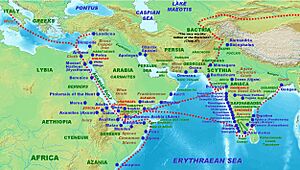
In 823 AD, two bishops from Syria, Mar Sabor and Mar Proth, came to Quilon with their followers. After the Kollam Era began in 825 AD, Quilon became the most important city in the Malabar region. The Kollam Port was started by Mar Sabore in 825. It was an important place for trade, replacing older ports. Many Syriac Christians also moved to Kerala in the 9th century, with their first big move being to Kollam in 823 AD.
The Kollam Era: A New Calendar
The Kollam Era (also known as Malayalam Era or Kollavarsham) is a special calendar used in Kerala, India. It started in 825 CE in Kollam. This calendar replaced an older Hindu calendar and is still used today for temple events, festivals, and farming activities in Kerala.
One main idea about how the Kollam Era started is that it began when a new church, Tharissappally Church, was built in Kollam. At first, only the local area used this new calendar. But as the Kollam port grew into a major trade center, other kingdoms also started using it.
Trade with Persia and Arabs
Sulaiman al-Tajir, a Persian merchant who visited Kerala in the 9th century CE, wrote that there was a lot of trade between Kerala and China through the port of Kollam. Many foreign accounts also mention a large Muslim population in the coastal towns. Arab writers like Al-Masudi and Ibn Battuta wrote about the Muslim communities in Kerala.
Historical Records: Copper Plate Inscriptions from Kollam
The Tharisappalli Copper Plates (849 AD) are very important historical documents. They are a copper-plate grant given by the King of Venad (Quilon), Ayyanadikal Thiruvadikal, to the Syriac Christians (also called Nasranies) on the Malabar Coast. These plates describe a gift of land to the Syrian Church near Kollam, along with special rights and benefits for the Syrian Christians.
These copper plates are important because their date is known very accurately. They also show how taxes were collected in early Venad, mentioning taxes on jobs, sales, and vehicles. They also prove that the rulers of ancient Kerala were open to different religions. The documents were signed in Hebrew, Pahlavi, and Kufic languages.
Kollam and the Venad Kingdom
The Kingdom of Quilon, or Venad, was one of the main medieval kingdoms on the Malabar Coast in South India. Venad ruled Kollam from the 9th century CE until the early 18th century, when it became the Kingdom of Travancore.
The rulers of Quilon were connected to the older Ay kingdom and the Later Cheras. The last Chera ruler, Rama Varma Kulashekhara, became the first ruler of an independent state of Quilon. In the early 14th century, King Ravi Varma briefly ruled over much of South India. After his death, Quilon mainly included parts of today's Kollam district and Thiruvananthapuram district in Kerala, and Kanyakumari district in Tamil Nadu. Marco Polo said he visited Kollam, calling it a major center for trade with China and the Levant. Europeans came to the region in the late 1400s, mostly looking for black pepper. Quilon was a very early version of Travancore.
In the ancient Sangam age, most of present-day Kerala was ruled by the Chera dynasty, Ezhimala, and Ay rulers. Venad was part of the Ay kingdom. By the 9th century, Venad became a semi-independent part of the Later Chera Kingdom. In the 11th century, the region came under the Chola empire.
During the 12th century, the Venad dynasty grew stronger. The capital of the war-torn Later Chera Kingdom moved to Kollam, and the Kulasekhara dynasty joined with the Venad rulers. The port of Kollam was visited by syriac Christians, Chinese, and Arabs. While Kozhikode was the most important port in medieval Kerala, Kollam, Kannur, and Kochi were also important secondary ports where traders from around the world gathered.
The Portuguese Wars: European Influence Begins
The Portuguese arrived in India in 1498, opening a direct sea route from Europe. They were the first Europeans to come to Kollam. They set up a trading center in Tangasseri, Kollam, in 1502. The Queen of Quilon first invited the Portuguese in 1501 to talk about spice trade. In 1503, the Portuguese General Afonso de Albuquerque came to Quilon and collected spices. Many believe that the colonial era in India began when the Portuguese set up their trading center in Quilon in 1502.
Portuguese Trading Post in Quilon
Afonso de Albuquerque sent ships to Quilon to get more spices, especially pepper. He heard that the Zamorin of Calicut was sending a fleet to Quilon to stop them from trading with the Portuguese. Albuquerque went to Quilon himself. The Queen of Quilon did not want fighting in the harbor. Albuquerque agreed and signed a trade agreement, setting up a permanent Portuguese trading post (called a factory) in Quilon in 1503. This was the start of a strong trade relationship between Portugal and Quilon, making Quilon a key center for pepper trade.
The End of Portuguese Power
The trade between Quilon and the Portuguese faced problems due to a fight between Arabs and Portuguese at the Port of Quilon. A Portuguese captain saw an Arab ship loading pepper, which led to a battle. Thirteen Portuguese men were killed, and a church was burned down. To stop more destruction, the Queen of Quilon signed a treaty with the Portuguese. This gave the Portuguese special tax breaks and control over the spice and pepper trade. The royal family also agreed to rebuild the destroyed church.
The Portuguese controlled Quilon until 1661. They fought with Arab traders and took a lot of gold. But when the Dutch arrived and signed a peace treaty with Quilon, the Portuguese started losing their power. Eventually, Quilon officially became a Dutch protectorate.
Dutch Rule: 1661–1795
The Dutch began expanding their empire to India in 1602. They arrived in Quilon in 1658 and signed a peace treaty in 1659. This made Quilon an official protectorate of the Dutch. Their officer, Rijcklof van Goens, placed soldiers in the city to protect it from the Portuguese and British. The western part of Quilon, including Tangasseri, was then called 'Dutch Quilon'.
Johan Nieuhof described Kollam and Tangasseri during the Dutch occupation: The city had strong stone walls and eight towers. Its large suburbs were called Colang-China by the Portuguese. Kollam was divided into two parts: the upper part, where the king and queen lived, and the lower part, which the Portuguese used to control.
There were many churches and monasteries, including a famous church built by the Christians of Saint Thomas. Most of the houses were grand and built of stone. The governor's castle was magnificent and near the sea. The Dutch later made the city smaller and stronger, pulling down most churches and public buildings, but keeping the castle, Saint Thomas Church, and some monasteries.
Travancore Takes Over
In the early 1700s, the Travancore royal family adopted new members. Travancore became the most powerful state in Kerala after defeating the Zamorin of Kozhikode in 1755. In the mid-1700s, Travancore's Raja, Marthanda Varma, decided to unite different kingdoms, including Quilon. The Dutch had made Quilon strong, but Marthanda Varma's army attacked and defeated the Dutch at Colachel in 1741. After signing the Treaty of Mannar, several areas around Quilon became part of the Travancore Kingdom.
On October 17, 1795, the Dutch handed over Tangasseri to the British East India Company. This happened after the Dutch were defeated in Cochin. The Dutch territories were officially given to the British Government in 1841. The takeover of Tangasseri was peaceful, as its importance as a military base had decreased.
Kollam remained part of Travancore until August 15, 1947, when India became independent.
British Influence and Protectorate
In 1795, the British gained influence in Quilon through a treaty with the Kingdom of Travancore. In 1811, John Munro set up the British Residency in Kollam. By 1856, Kollam became one of the three main administrative divisions of the princely state of Travancore. In 1904, the Kollam–Sengottai Chord Line was built by the British. This was the first railway line in Travancore, connecting it to the Madras Presidency. In the 1920s, the British also built an Air strip in Kollam called Quilon Aerodrome, which was the first aviation facility in the region. In 1936, a town hall called Sri Moolam Thirunal Palace was built in Quilon.
Social Changes and Reforms
Before India's independence, Kollam saw many social and political struggles. These included the Kadakkal Revolt against the administration and the Kallumala Samaram against unfair caste practices.
After Independence: Kollam Joins India
Between August 15, 1947, and July 1, 1949, Kollam was part of the Travancore state within the new Dominion of India. On July 1, 1949, Quilon became one of the four districts in the newly formed Travancore–Cochin state. On November 1, 1956, when the State of Kerala was formed, Quilon district (which included parts of today's Pathanamthitta district) became part of Kerala. Later, on November 1, 1982, some parts of Kollam were added to the newly formed Pathanamthitta district.
Many Names for Kollam
Throughout history, travelers have called Kollam by many different names. Here are some of them:
| Number | Name | Description |
|---|---|---|
| 1 | Quilon | This is the English version of the name Kollam. The Portuguese, Dutch, and British used it during their rule. |
| 2 | Desinganadu | Kollam was part of the old kingdom of Desinganadu. This kingdom was known for trading with other countries, and Kollam was an important port. |
| 3 | Venad | Kollam was also a major city in the Venad kingdom, which was one of the main kingdoms in Kerala. The rulers of Venad had their capital in Kollam for some time. |
| 4 | Kurakkeni Kollam | This name is found in some old writings and plates. |
| 5 | Elancon | Kollam has existed for many centuries and was called Elancon by early travelers. |
| 6 | Kaulam Mali | Used by the Arab traveler Solyman (851) as Kaulam Malay. |
| 7 | Coilum | Used by the 13th-century Venetian traveler Marco Polo. |
| 8 | Male | Used by Cosmas Indicopleustes. |
| 9 | Chulam | The Jewish traveler Benjamin of Tudela (1166) called Kollam Chulam. |
| 10 | Kiulan | Jean Pierre Guillaume Pauthier used this name when talking about some Chinese documents. |
| 11 | Coilon/Coilun | Used by the Mamluk-era geographer and historian Abulfeda (1273 C.E.). |
| 12 | Kulam | Used by the Italian merchant Marco Polo (1298 C.E.). |
| 13 | Polumbum | Used by Odoric of Pordenone (1322), an Italian friar and explorer. |
| 14 | Colonbio | Found in the Palatine MSS of Odoric (1322). |
| 15 | Columbum | Used by Jordanus (1328) and John of Marignolli (1348). |
| 16 | Colombo | Found in letters from Pope John XXII to the Christians of Quilon (1330). |
| 17 | Kaulam | Used by Ibn Battuta (1343), a famous explorer. |
| 18 | Coloen | Used by Niccolò de' Conti (1430), an Italian merchant and explorer. |
| 19 | Colon | Used by Ludovico di Varthema (1510), an Italian traveler. |
| 20 | Coulam | Used by Duarte Barbosa, a Portuguese writer (between 1500 and 1516). |
| 21 | Colour | Used by Sammario Ramusio. |
| 22 | Colam | Used by GD Empoli (1530). |
| 23 | Polomee/Polumbum | Used in the book Travels of Sir John Mandeville (1592). |
| 24 | Mahali | Used during the time of the Tang dynasty of China. |
| 25 | Tarsish | Found in some old plates and inscriptions. |


